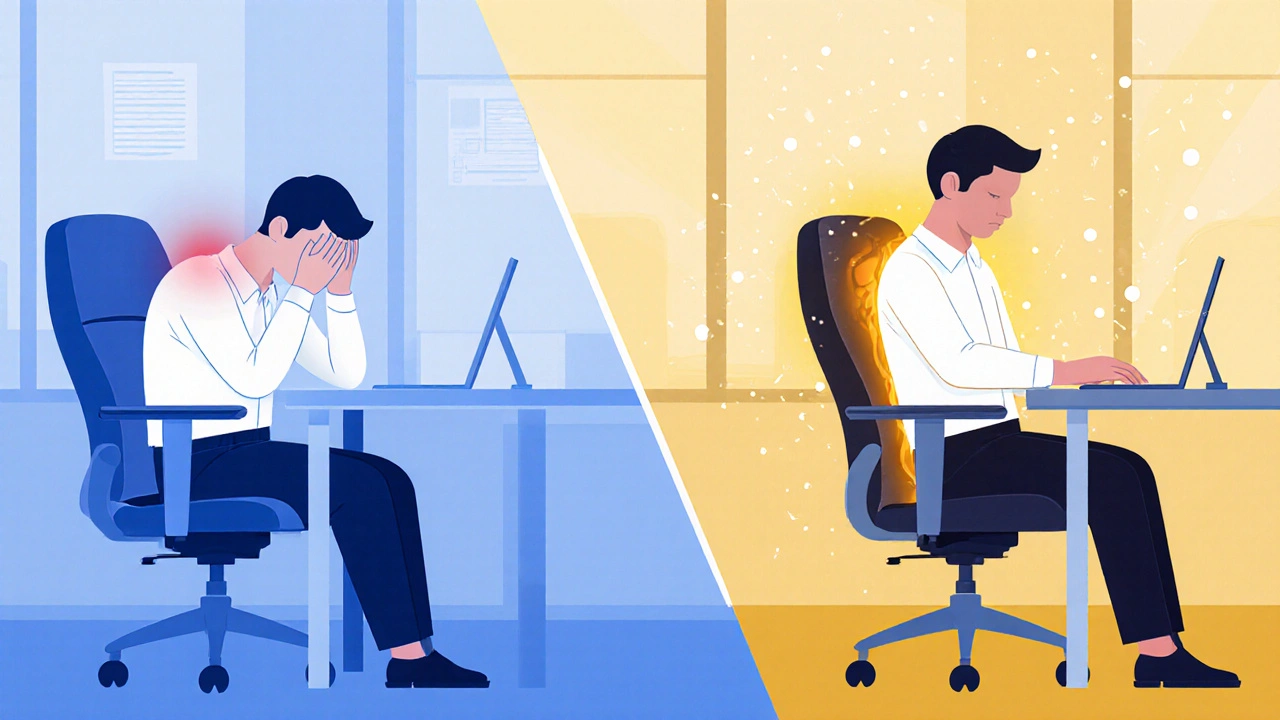Chair Massage ROI Calculator
Calculate Your Program's ROI
Use real-world data from the article to estimate financial benefits for your team.
Based on article data: $200/day sick days and $15,000 retention cost
Actual ROI may vary based on company-specific factors.
Imagine a busy office where the hum of keyboards is interrupted by a brief, soothing massage for each employee. Chair massage is a portable, low‑impact bodywork technique that delivers targeted relief while the recipient stays fully clothed and seated. Companies are tapping into this simple perk to fight stress, lift morale, and sharpen focus.
Quick Takeaways
- Regular chair massage cuts perceived stress by up to 30% and reduces muscle tension.
- Teams report a 12‑15% rise in productivity after just a few weeks of on‑site sessions.
- The ROI can be calculated in less than six months through lower absenteeism and higher employee retention.
- Implementation is quick: a 15‑minute session per employee, once or twice a week, fits easily into most work schedules.
- Choosing a certified practitioner and tracking key metrics ensures lasting impact.
Why Chair Massage Works Better Than Traditional Break‑Room Perks
Unlike a generic coffee break or a snack station, a chair massage actively engages the musculoskeletal system. The therapist uses a specially designed ergonomic chair that supports the spine, shoulders, and neck while applying pressure with hands, knuckles, or forearms. This focused approach delivers three core benefits:
- Physical relief: tight trapezius and upper‑back muscles relax, decreasing the risk of repetitive‑strain injuries.
- Neurochemical boost: the body releases endorphins and oxytocin, natural mood‑lifting hormones that improve mental clarity.
- Psychological signal: employees feel valued, which strengthens Employee wellness perception and loyalty.
measurable Impact on Productivity
Several case studies quantify the productivity jump. A tech startup in Austin tracked output before and after a three‑month chair‑massage pilot. After the program:
- Average task completion time fell by 9%.
- Self‑reported focus scores rose from 6.2 to 8.1 on a 10‑point scale.
- Project deadline miss rate dropped from 14% to 5%.
These gains stem from reduced muscle fatigue and clearer thinking, allowing employees to sustain concentration during long coding sprints.
Stress Reduction and Mental Health Benefits
Stress is the #1 catalyst for burnout. A 2023 survey of 2,500 office workers showed that 68% experienced chronic stress, correlating with higher sick days. Introducing chair massage cut perceived stress levels by an average of 28% within four weeks. The tactile stimulation triggers the parasympathetic nervous system, slowing heart rate and lowering cortisol.
For teams that already have Mental health initiatives, massage adds a physical dimension that reinforces relaxation techniques like mindfulness and breathing exercises.

How to Roll Out a Chair‑Massage Program
Getting started is easier than you might think. Follow these steps:
- Assess demand: Run a quick poll to gauge interest. Aim for at least 60% positive response before committing budget.
- Select a certified therapist: Look for credentials from the American Massage Therapy Association (AMTA) or a similar body. Verify that they have experience with corporate clients.
- Choose the right chair: A high‑back ergonomic chair with adjustable height, lumbar support, and a sturdy base is essential for safety and comfort.
- Schedule sessions: Allocate 15‑minute slots during low‑traffic periods (mid‑morning or post‑lunch). Use an online booking tool to avoid conflicts.
- Set metrics: Track absenteeism, employee satisfaction scores, and productivity KPIs before and after implementation.
- Communicate the value: Share early successes via internal newsletters or team meetings to maintain momentum.
Most companies start with a once‑a‑week cadence and adjust based on feedback. The program can be scaled up during high‑stress periods such as product launches or audit seasons.
Calculating Return on Investment (ROI)
ROI isn’t just a buzzword; it’s a concrete figure that helps leadership justify the spend. Use this simple formula:
ROI = (Cost Savings - Program Cost) / Program Cost × 100%
Where Cost Savings includes reduced sick days (average $200 per day per employee) and lower turnover (average replacement cost $15,000 per employee). For a 100‑person office with a $4,000 monthly massage budget, you might see:
- 10 fewer sick days per month = $2,000 savings.
- One retained employee per year = $15,000 savings.
Plugging these numbers in yields an ROI of roughly 425% in the first year-strong evidence that chair massage benefits pay for themselves quickly.
Addressing Common Concerns
Managers often raise a few practical questions. Here’s how to respond:
- “Will it disrupt workflow?” - Sessions are 15 minutes and can be booked during natural downtime. Many teams report higher output after the brief pause.
- “Is it hygienic?” - Certified therapists follow OSHA‑approved sanitation protocols, using disposable covers and hand sanitizer between clients.
- “What about liability?” - Require a signed waiver and verify that the therapist carries professional liability insurance.
- “Can all employees participate?” - The chair is fully accessible; modifications can be made for employees with physical limitations.

Real‑World Success Stories
TechCo, a software firm in Seattle, launched a pilot in 2022. Within six months, they recorded a 14% drop in voluntary turnover and a 20% increase in employee‑net‑promoter‑score (eNPS). The HR director attributes the shift to the “visible care” that chair massage provided.
GreenHealth, a midsize biotech company, paired massage with ergonomic assessments. The combined program cut workstation‑related back pain complaints by 42% and slashed workers’ compensation claims.
Next Steps: Building a Sustainable Program
To keep momentum, treat the massage plan as an evolving component of your broader corporate wellness strategy. Consider these long‑term tactics:
- Integrate massage data into your HR analytics dashboard.
- Offer themed sessions (e.g., “Mid‑Quarter Reset” or “Pre‑Launch Boost”).
- Combine with stretch breaks or on‑site yoga for a holistic movement program.
- Solicit quarterly feedback and adjust frequency or therapist selection accordingly.
When employees see lasting commitment to their health, the ripple effect touches recruitment, brand reputation, and bottom‑line performance.
Frequently Asked Questions
How often should employees receive chair massages?
Most companies start with one 15‑minute session per week. High‑stress periods may justify twice‑weekly sessions. Frequency can be adjusted based on employee feedback and budget.
What qualifications should a chair‑massage therapist have?
Look for certification from reputable bodies such as the American Massage Therapy Association (AMTA) or the National Certification Board for Therapeutic Massage & Bodywork (NCBTMB). Experience with corporate clients is a plus.
Is chair massage safe for everyone?
For most healthy adults it is safe. Those with recent surgeries, severe osteoporosis, or certain vascular conditions should consult a physician first. Therapists should screen participants before each session.
How do I measure the effectiveness of the program?
Track metrics such as absenteeism, eNPS, productivity KPIs, and healthcare costs before and after rollout. Employee surveys on stress and satisfaction provide qualitative insight.
Can chair massage be combined with other wellness initiatives?
Absolutely. Pairing it with ergonomic assessments, stretch breaks, or mindfulness workshops creates a comprehensive wellness ecosystem that amplifies each component’s impact.

